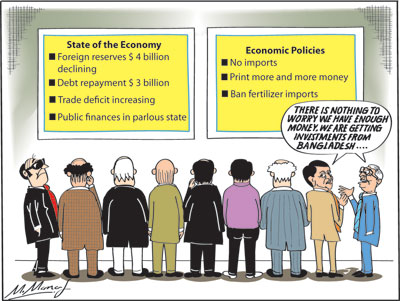Columns
Inappropriate economic policies in a weak state of the economy
View(s): The country is heading towards a severe economic crisis. External finances are perilously low; foreign debt repayments are large; weak public finances severely limit the capacity of the government to take adequate measures to alleviate the escalating poverty by providing income support and prevent starvation or stimulate economic growth.
The country is heading towards a severe economic crisis. External finances are perilously low; foreign debt repayments are large; weak public finances severely limit the capacity of the government to take adequate measures to alleviate the escalating poverty by providing income support and prevent starvation or stimulate economic growth.
These fragile financial conditions are compounded by inappropriate policies. The sudden banning of chemical fertiliser is a clear example of this. It will reduce agricultural output, increase import expenditure, reduce export earnings and decrease incomes of farmers and agricultural workers. Food prices are likely to soar. Large-scale hunger and starvation is likely if there aren’t adequate food imports.
Policies
Inappropriate economic policies and ineffective administration have depressed incomes, increased prices of essential consumer items, decreased food availability and accessibility and aggravated poverty and starvation.
 Fertiliser ban
Fertiliser ban
In this economic context, the banning of fertiliser has added fuel to the burning economic crises. Undoubtedly the economy is heading towards a crisis of severe proportions where hunger and starvation would reach huge proportions.
Food production
The banning of chemical fertiliser will reduce food production by more than half that of last year, deny incomes to a large proportion of the rural community engaged in farming or dependent on it. Rural poverty would be widespread.
Export crops
The lack of fertiliser, weedicides and pesticides for tea cultivation would decrease tea production on estates and smallholdings and tea export earnings would decrease. This would deprive smallholders who produce 80 percent of tea their livelihoods.
Food imports
The sharp fall in rice and food production would necessitate the import of a large quantity of rice in an international grain market where grain prices are nearly 50 percent higher than a year ago. The fact that the Government is calling for tenders to import 150,000 metric tons of rice is evidence of the shortfall in production and the need for imports. Wheat imports too have increased this year.
Cause
The root cause for this predicament is the expected shortfall in rice production this Yala due to the lack of fertiliser. If the Maha paddy cultivation that begins around September too is deprived of fertiliser, there would be a huge reduction in paddy production.
Impact
The impact of the ban on chemical fertilisers is to reduce food and export crop production drastically, deprive farmers of their livelihoods, increase the incidence of poverty and hunger, increase import expenditure and reduce export earnings.
Export earnings
The reduction in agricultural export earnings at a time when manufactured exports are under threat of a withdrawal of the GSP plus concession by the EU is catastrophic. Although a Government spokesman is confident that the withdrawal of GSP plus would not matter, export manufacturers consider it a severe threat. The Apparel Exporters Association has said that it will affect the country’s exports severely. Furthermore, if other countries that are main markets for our manufactured exports also withdraw concessions, the country’s exports would be seriously jeopardised.
Misconception
The apparent divergence of views on the adoption of organic agriculture is a misconception. Everyone agrees that organic agriculture is superior to cultivation with chemical fertilisers, insecticides and pesticides. Organic agriculture is good for the environment, organic food is healthier and less harmful to health. Agronomists and other scientists do not disagree on this.
It is also true that small extents of land are successfully cultivated organically. These crops are sold at a much higher prices, locally as well as exported to niche markets. About 21 percent of world agriculture is organic.
Organic agriculture
The critical issue is that organic agriculture cannot produce adequate food to feed the world population. No country in the world has a large proportion of its land under organic agriculture.
Bhutan that tried to convert to organic agriculture reverted to conventional agriculture. About a third of their agriculture is organic cultivation. The US, Australia, Switzerland, China and India have large extents under organic cultivation. Yet most of their produce is not organic.
Paddy production
It is estimated that production of our staple rice will fall by over half. This implies that the country that is more or less self-sufficient in rice in a normal year would need to import about 250,000 metric tons. And that would not be organically cultivated rice.
The paddy output this Yala and in Maha 2021/22 would be much lower as we are hardly prepared for extensive organic cultivation. Next Maha may be a season of hardly any cultivation of paddy.
Tea
The fall in production of tea and other export crops mean a drastic reduction of export earnings that we can ill-afford. Smallholder cultivation would be the worst affected and most damaging to exports.
External finances
When the need of the hour is to strengthen our external reserves by increasing exports and decreasing imports, the banning of chemical fertiliser, pesticides and insecticides would increase imports and reduce exports. That in a nutshell is the paramount issue.
Retrospective reflection
In the 1950s, the country imported over one half of the requirements of food. This included rice, wheat flour, sugar, poultry and a wide variety of foods like lentils (dhal), chilies and other condiments.
Particularly significant is the fact that Sri Lanka imported over one-half of the country’s rice requirements to feed a population of about seven million. Last year, as in recent years, the country was self-sufficient in rice. Rice production was adequate to feed a population of 22 million.
This self-sufficiency in rice was achieved by both an expansion in the area cultivated by expanding irrigation and most significantly, by more than a twofold increase in rice yields.
Rice yields that were about 40 bushels per acre in the 1950s are about 100 bushels per acre in the dry zone. This over two-fold increase in yields was achieved by adopting high yielding varieties (HYV) like IR8 and appropriate fertilisers.
Green revolution
In the 1960’s when there was widespread global hunger a scientific revolution in agriculture well known as the “Green Revolution” paved the way to a doubling and trebling of rice, wheat and maize yields. The adoption of these high yielding seed varieties enabled Sri Lanka to feed her 22 million people. We are on a path to reverse this achievement and return to a large rice importing nation at a time when we do not have the resources to import rice.
Last word
Finally, all the above factors considered, the ban on fertilisers, will aggravate the country’s perilous finances into a deeper crisis and drive the people into hunger and starvation.


Leave a Reply
Post Comment